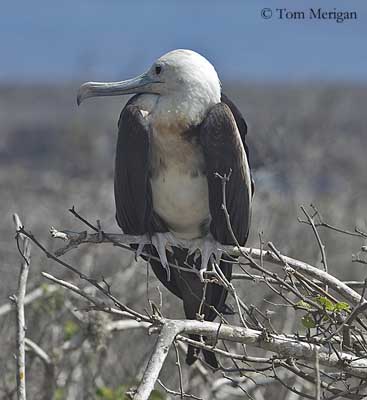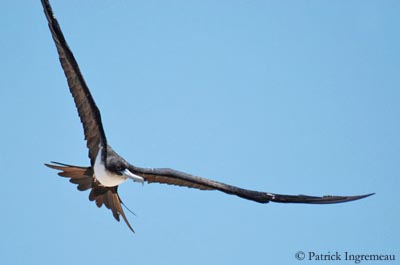
DIET:
The Greater Frigatebird feeds mainly on fish (flying-fish) and squid. But it also feeds on eggs and chicks of other seabirds, young turtles, carryon and fish scraps.
PROTECTION / THREATS / STATUS:
The Greater Frigatebird’s populations are not globally threatened. This species can be threatened by habitat destruction and disturbance, and sometimes direct persecution. They can be preyed upon by introduced cats and rats on breeding areas.
Fr: Frégate du Pacifique
All : Bindenfregattvogel
Esp : Rabihorcado Grande
Ital : Fregata minore
Nd : Grote Fregatvogel
Sd : Större fregattfågel
Photographers :
Patrick Ingremeau
TAMANDUA
Tom Merigan
Tom Merigan’s Photo Galleries
Text by Nicole Bouglouan
Sources :
HANDBOOK OF THE BIRDS OF THE WORLD vol 1 by Josep del Hoyo-Andrew Elliot-Jordi Sargatal - Lynx Edicions - ISBN: 8487334105
L’ENCYCLOPEDIE MONDIALE DES OISEAUX - Dr Christopher M. Perrins - BORDAS - ISBN: 2040185607
BIRDS OF ASIA AND AUSTRALIA by David Alderton – Southwater - ISBN : 184215978X
BirdLife International (BirdLife International)
Wikipedia, the free encyclopaedia
XENO-CANTO – Sharing Birds sounds from around the world
Great Frigatebird
Fregata minor
Suliformes Order – Fregatidae Family
BIOMETRICS:
Length: 85-105 cm
Wingspan: 205-230 cm
Weight: M: 1000-1450 g - F: 1215-1640 g
DESCRIPTION:
The Greater Frigatebird is a large black seabird, often seen gliding gracefully along water surface.

Adult male has black plumage overall. It has red gular pouch on the throat. On back and scapulars, we can see black feathers with dark green iridescence. The male shows also pale brown wing bar, forming a V on the upperparts when flying.
The underparts are black. The tail is deeply forked. The Underwing is silvery-grey.
The head is glossy black. The long, thin, hooked bill is greyish. The eyes are dark brown. Short legs and feet are pale brown.
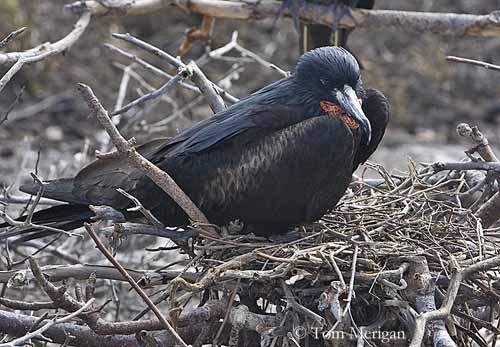
The female has white breast and grey throat, and lacks the red bare skin on the throat. She is larger than male and she had red eye-ring and whitish bill.
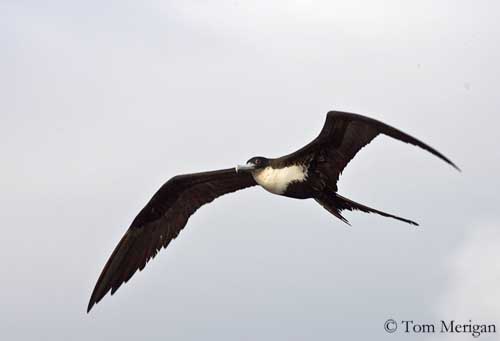
Juvenile and immature show complex series of plumages with tawny and white on head and breast, and white underparts, decreasing little by little for reaching the adult plumage and their sexual maturity at about 8 or 10 years of age.
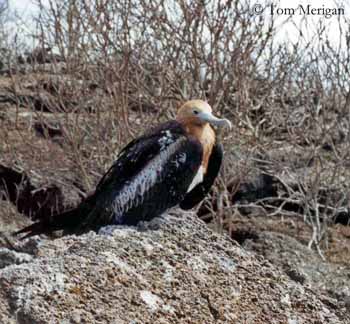
We can find five subspecies, very similar, with only different sizes and bare part colours.
F.m. aldabrensis (W Indian Ocean);
F.m. minor (E Indian and SW Pacific Oceans);
F.m. palmerstoni (W and C Pacific);
F.m. ridgwayi (E Pacific);
F.m. nicolli (S Atlantic Ocean).
VOICE: SOUNDS BY XENO-CANTO
The Greater Frigatebird, as other frigatebirds is usually silent, except at breeding colonies. The male may be very vocal during displays. The Greater Frigatebird produces gobbling sounds as turkeys. Male and female have different calls, and perform a kind of bill-clattering. At this moment, both mandibles vibrate rapidly. The courting male uses its inflated pouch as sound-box.
Young birds squeal and chirp while they beg for food.
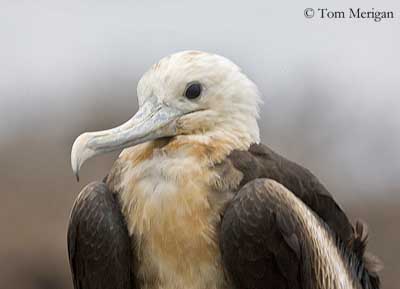
HABITAT:
The Greater Frigatebird lives in tropical and subtropical seas. It breeds on small islands, mangroves or bare grounds. This bird feeds in the ocean, within 80 km from roost and colony.
RANGE:
The Greater Frigatebird is mainly found in the Pacific (including Galapagos Islands) and Indian Oceans, and there is a population in South Atlantic.
BEHAVIOUR:
The Greater Frigatebird feeds while flying, snatching its prey from below the surface or from the air, when it catches flying-fish. It cannot alight on water surface because it is not able to take off from water.
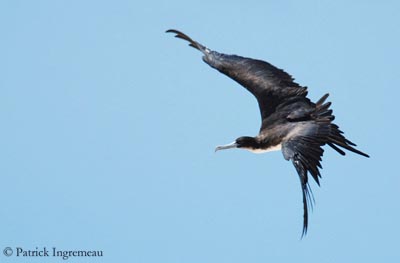
Young birds can harass other seabirds, chasing them until they regurgitate their food. the Greater Frigatebird also hunts for other bird’s chicks at breeding colonies.
During the breeding season, the male inflates its gular pouch, in order to attract a female. The sac can remain inflated for 20 minutes as a red balloon. The males are often in groups, sitting in old nests, and they are not aggressive towards each other.
Each male spreads its wings, in order to display the silver-coloured feathers below. It inflates the red gular pouch with bill pointed upwards. The females are flying above them, and at this moment, each male quivers wings and head in bursts of excitement, the bill vibrates against the inflated pouch and produces a kind of drumming noise.
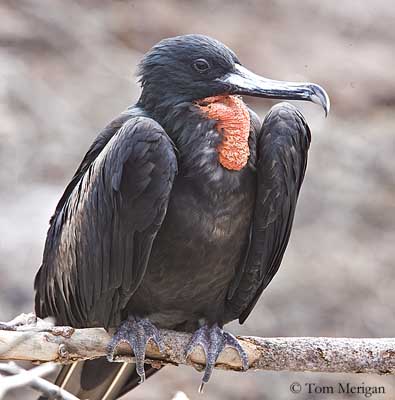
When a female chooses a male, she flies down and joins it, and both perform some rituals such as “head-snaking”, or male taking female’s bill in its own. Pair bonds occur within three days. Then, when the pair is formed, they establish a territory and the nest-site which is strongly defended because intruders often try to steal nest materials.
This species has long breeding cycle (two years) and the birds are seasonally monogamous.
FLIGHT:
The Greater Frigatebird spends most of time in the air, in effortless soaring. It can rise very high in the sky. It has very well adapted body for an aerial life, with its distinctive flight silhouette. It can soar for hours or days.
For a large size, frigatebirds are very light in weight, with only 5% for bones, that allows them to perform their acrobatic flights.
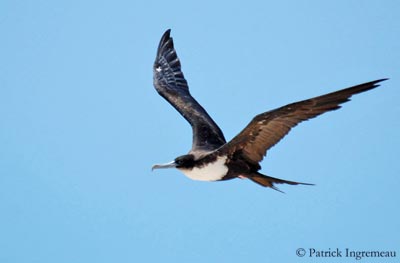
REPRODUCTION:
The Greater Frigatebird can breed at any time of the year, according to the location, but mainly during the dry season.
The Greater Frigatebird nests in colonies, in bushes or trees, and sometimes on the ground in bare areas. The colonies can contain ten to several thousands of pairs, and they can breed with other seabirds’ species.
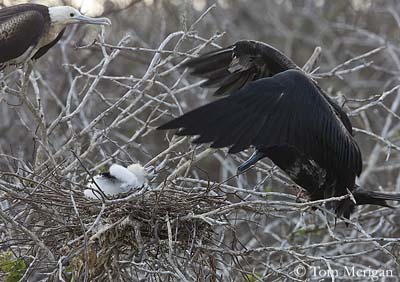
The male collects nest materials such as dead twigs or leaves, or it can steal materials from other nests. It can also add seaweeds and feathers.
The female builds the nest and moulds these materials until forming a rough nest. She defends it against other males searching for nest-materials. The nest can be placed at about 15 metres above the ground or lower. In some parts of the range where vegetation is scarce, the nest is just a scrape in the ground.
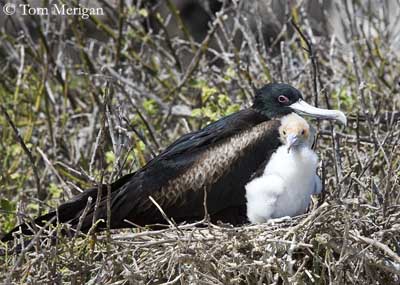
The female lays only one dull white egg. Incubation lasts about 55 days, shared by both parents which have brood patches. They take turns of one to four days, sometimes much more, up to 18 days before to be relieved!
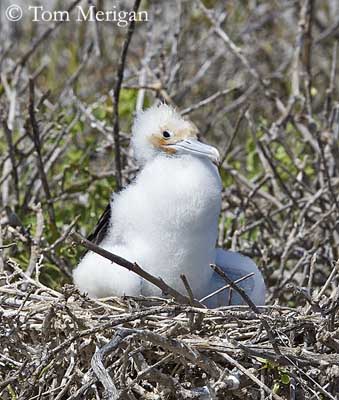
The chick hatches altricial, and it is brooded the first two weeks, until it is covered in white down. The adults guard it, also by taking turns. The chick is fed by regurgitation, receiving several meals just after hatching, and later, only every one or two days.
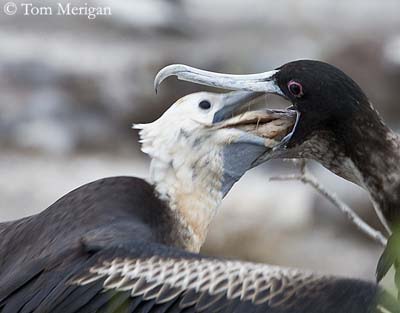
The young fledge between 4 to 6 months, depending on food resources availability. The parents feed the chick after fledging for long period, between 5 to 18 months.
This species produces one brood every two years, sometimes 3 or 4 years.
